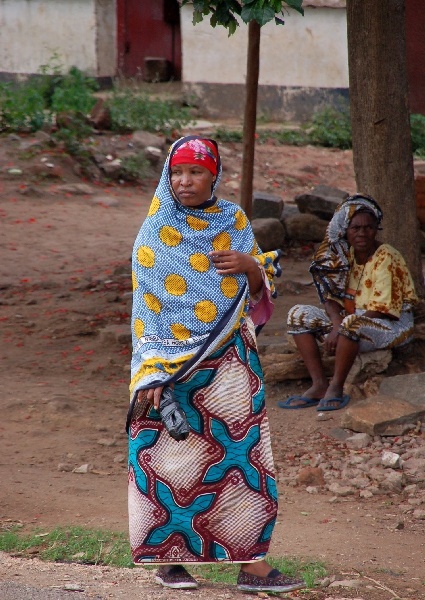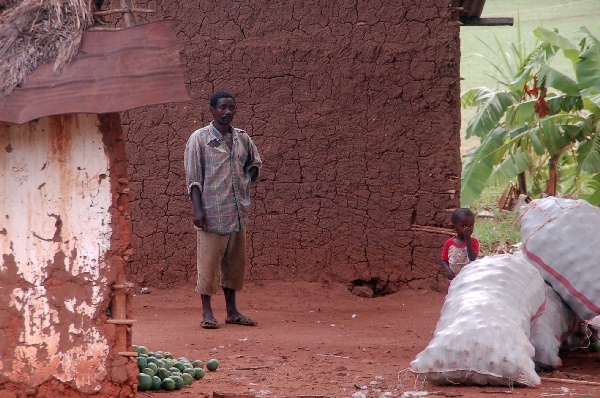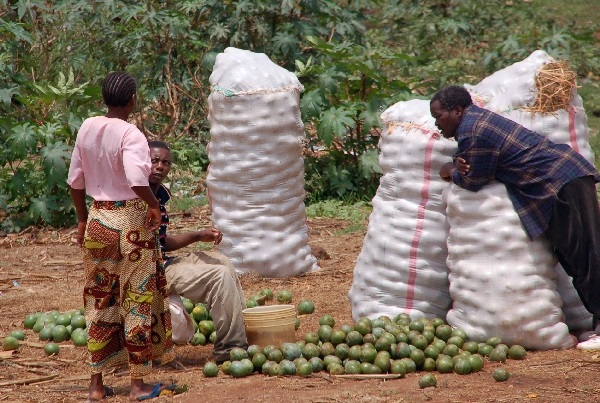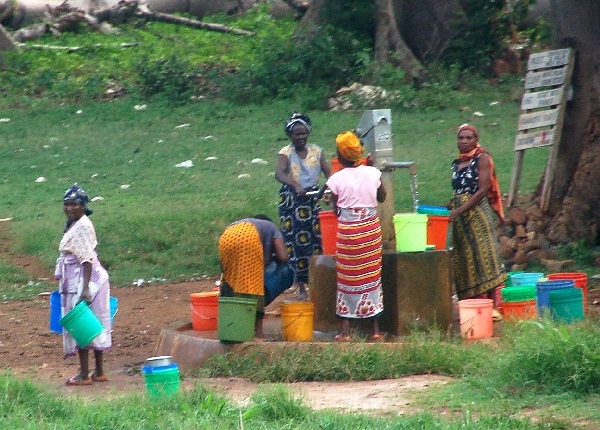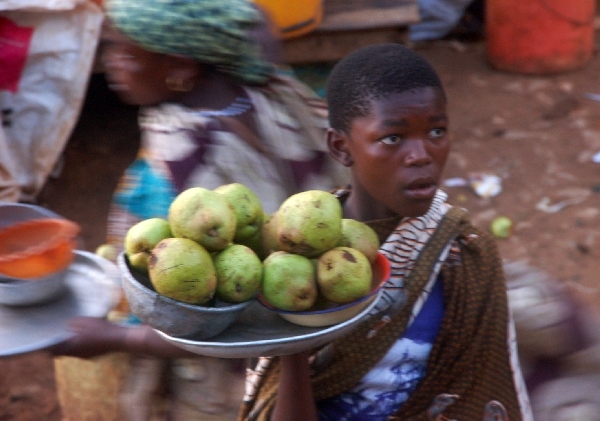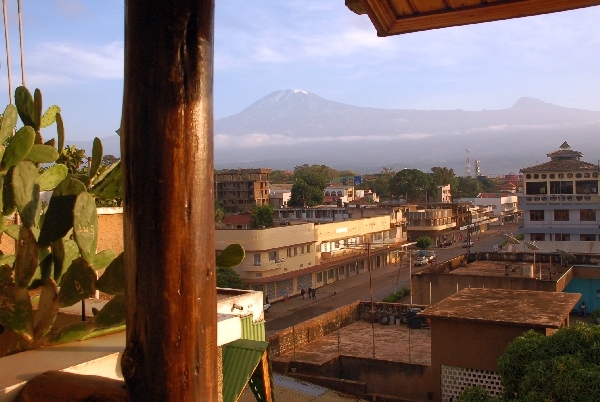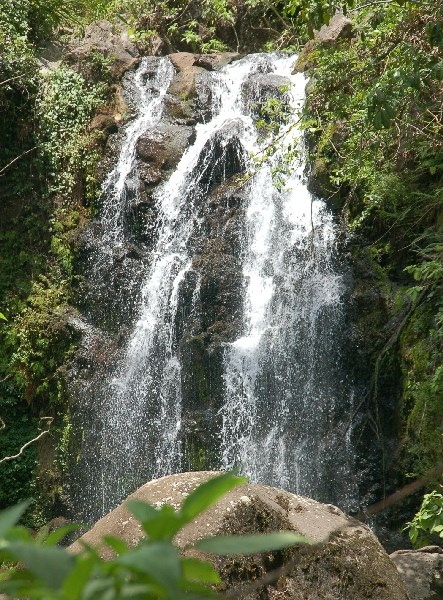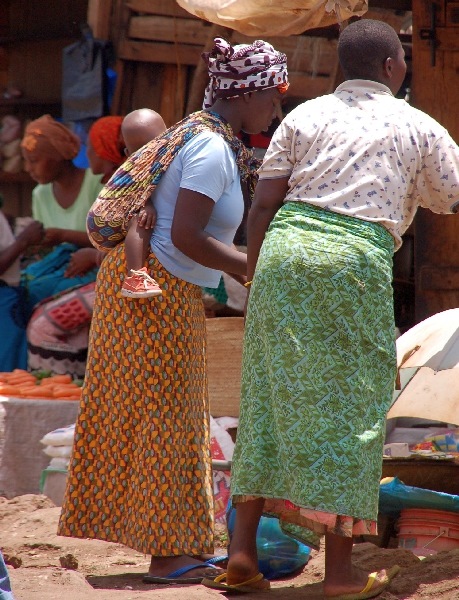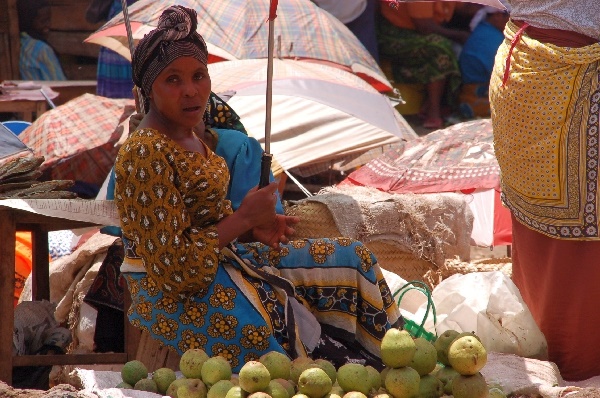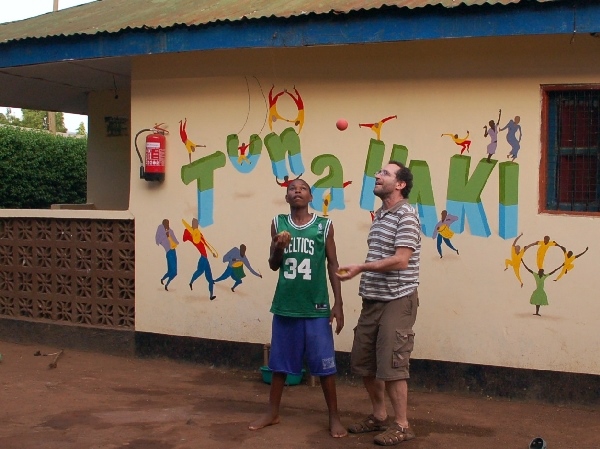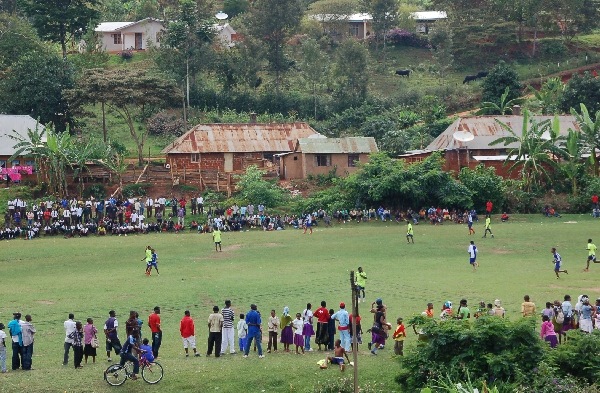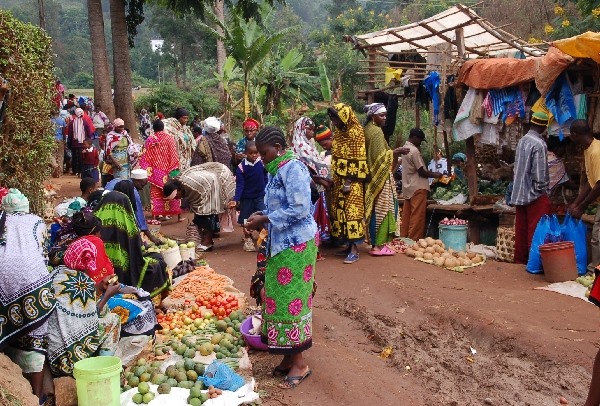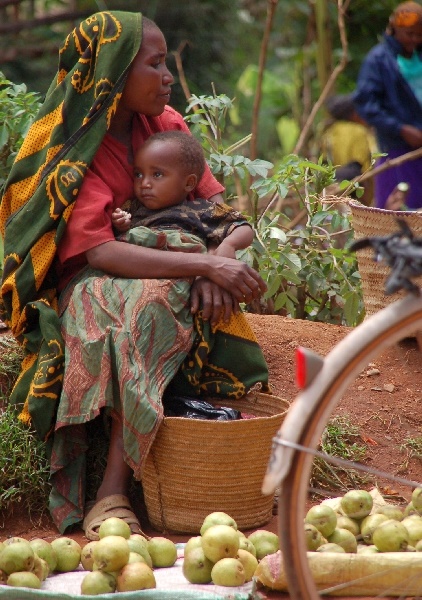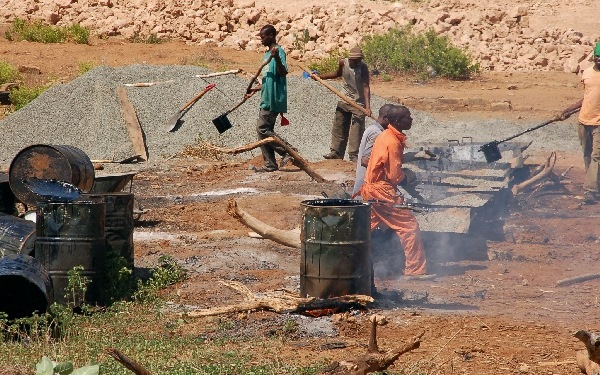World traveler Clown Tom Bolton
Adventure stories & photos

Tom’s travels to Tanzania part 2
Zanzibar direction Moshi & Kilimanjaro
We took the fast ferry from Zanzibar, covered on Tanzania part 1, back to the mainland via Dar el Salaam. Was double the price of the cargo ferry but in this direction it would have gone overnight which was a bit too long. I found it comfortable but my wife found it confining with no chance for fresh air. Back in Dar we stayed just one night, this time at the Safari Inn which was popular amongst travelers and better than the YWCA but not quite as nice as the nearby Econolodge and caught a bus north to Moshi. The city of Arusha is bigger and is the major one for people planning treks on Kilimanjaro. We weren’t going trekking and had heard that Moshi was quieter, less hassles from the hordes of touts in Arusha.
Had to deal with the fact that most long range buses leave from a station well out of the city and one has to pay almost half of the fare again to get to the bus station by taxi. Taking local buses would be quite a stress with full baggage. The long range buses like the ones in the photos needed to be booked in advance and often had a lot of cargo on top or below yet they were much roomier than a dalla-dalla.
Views of the countryside
I took these photos from a couple of different bus windows. If one looks closely they will notice that vehicles drive on the left side in Tanzania and the drivers might be located on either the left or right side. Nothing spectacular but the images show examples of the typical houses outside the main cities; traditionally sticks covered with mud with thatch roofs, which are giving way to the more modern version of bricks with sheet metal roofs. All school kids, like the 2 in the one photo, seemed to have a uniform and feel proud to be learning. The building standard doesn’t look like much of an improvement but the protection against the elements and infestation of possibly disease carrying insects and rodents is probably noticeable.
People lined up at wells
Another thing one often saw while driving through small villages were the people crowded around the wells. Most were operated by a hand pump and were probably bored by machine to a good depth which is a great improvement over shallow dug, open wells. Problem was that they were small and people still spent hours waiting to fill their jerry cans, most of which were used cooking oil containers. I think this photo was actually from a market where the guy was selling water but it gives the idea and a typical scene would be a dozen people with hundreds of containers.
Vendors swarm at bus windows
The express buses usually had a scheduled stop for a meal at a good rest stop with restaurant and toilets. But even they, like the normal buses, seemed to make a lot of stops. These were typified by a swarm of vendors shouting at the windows with their offerings of fruits, nuts and drinks.
Health hazard: malaria & HIV
I heard estimations of the HIV infection rate in Tanzania being between 5 and 10 %. Not nearly as high as some African countries but enough to really burden such a poor land. To their credit, there were signs on the streets and also publications at the library giving warnings about AIDS.
We met a young Dutch doctor who was in a project trying to trace HIV infected people. They wanted to have some idea about survival rates amongst infected people which is impossible if you can’t find them. Problem was that street names and addresses for the most part don’t exist. Even big companies only have post office box numbers, so tracking someone down is difficult especially since one can’t say why one is looking for them. The stigmatism of Aids is a big problem yet it has become a cliché there that stigmatism is THE problem.
Malaria is also a major problem in Tanzania but as it was the dry season we opted to only take anti-malarials along for emergency treatment rather than for prophylaxis especially since enough of the recommended drug of choice, Malarone, would have cost us about 500 Euros each in Germany. Lariam is readily available and cheap but many people have strong side-effects to it.
Most hotels provided mosquito nets but they were often full of holes (I often repaired them with dental floss). We took a net with us which is recommendable although we never really used ours. If you can’t get a net already treated with insect repellent, there is a spray available from pharmacies – normally used against fleas that have infested your furniture. Thus the mosquitoes that land on your net quickly die rather than just wait until you have to get up.
Moshi & Kilimanjaro
Upon arrival in Moshi we ended up walking to the Backpackers hostel. Was quite a feat not to get followed by the local touts. Later we changed to the nearby Kindoroko hotel which was run by the same owners. We paid a bit more here but most of the rooms were double the price as they had their own bathroom. The advantage was a balcony to the street where one could see Kilimanjaro, the people comings and goings on the street – including a wedding procession in pick-up trucks.
We eventually moved to the Buffalo hotel which was quieter and a little cheaper and had the most popular restaurant right across from it serving pretty good Italian food which was a change of pace. Most of the hotels in town were named after animals and we joked that the Zebra hotel, where we ate a couple of times, should have been called the giraffe hotel since its ceilings were so incredibly high.
Kilimanjaro, Africa highest mountain is not technically hard to climb but because of its altitude the acclimatization is a problem and more than one person told us – it’s COLD on top. To climb it one has to go through an agency which will organize the required guide and porter(s) and one has to pay 50 US dollars per day park fees for a minimum 5 day trip. A couple told us that they took the cheapest, simplest version and still ended up with a guide and 9 porters for the 2 of them.
Rather than establishing proper places along the routes, they carry the tents and stove etc. up and down and up again for each trip. There are complaints that some porters are ill equipped for the extreme terrain and tourists complain that the porters can endlessly pressure you for tips and sabotage your trip if they don’t get what they want. I had just had a hernia operation and a nose operation within a couple of months before going on this trip, so I was not in condition to try for the top even if we had thought it worth the money and hassle. In the end I was content to see Kilimanjaro from a distance and from the lower slopes.
Tanzania tourist destinations
A bit more disappointing was missing the other big icon of Tanzanian tourism, visiting the Serengeti. Seems one can get a bus through the park for cheap without stopping or getting off of the main road, this sounded lame. Or there are tours that are pricey and often lead to a large group of vehicles at the same place trying to chase down a decent view of animals. Staying overnight in the park is also only done on a luxury budget.
We spent a lot of time gazing at Kilimanjaro as one always hoped for an even better view through the haze and clouds. Towards the end of our stay, we were treated to a fresh snowfall, which covered most of the upper peak. This contrast to the average view makes it painfully obvious that there is not much left of its glaciers. Although the height of Kilimanjaro will always catch the clouds, the ever-growing population in the area is facing some drastic shortages of water in the near future.
Marangu, slopes of Kilimanjaro
Next photos were on the outskirts of Marangu, a village northwest of Moshi on the lower slopes of Kilimanjaro which we made a day trip to. Wasn’t much in the village itself although one could buy some delicious looking fly covered fish drying on racks.
Fertile mountain terrain
As one would expect, the area is hilly and very green. Naturally such a fertile environment is an attractive place to live. There are many projects in the area to support farming or other strategies to provide a livelihood without robbing the mountain forests of their trees and animals. Perversely, this attracts even more people to the area which multiplies the difficulties. The woman here is carrying grass and the next bananas but often very heavy loads of wood etc. were often carried on the head.
Kibo Hotel Marangu
There is also a big old lodge called the Kibo Hotel in Marangu which personifies the great white hunter mentality of the colonial era. US President Jimmy Carter stayed here once which is prominently advertised out front. Amongst the hunting trophies displayed there were 2 elephant foot waste-baskets, one of which can be seen in the lower right side of the next photo. It looked like a Hollywood film set but no, such crass things do exist! We didn’t inquire about the presidential suite but we did have breakfast there.
Machame Village, Chagga caves
Northeast of Moshi is another nice village called Machame which is the gateway to one of the most popular routes up Kilimanjaro. We went there for 2 days staying in one of the few affordable (although overpriced) hotels which had no water. None of the hotels in town had a sign out front which I was openly told to be a strategy to avoid paying taxes. There are a couple of waterfalls called Nooro within walking distance of the village. Along the way to the biggest of the falls, one can visit local caves which are entered through holes in the ground covered with thatched roofs.
Supposedly, the local Chagga people hid in these caves during raids by Maasai tribes a couple of hundred years ago. The foliage anyway was very lush around the river area. Traudel and I went around without a guide which seemed to be frowned upon. There were just children rather than trained guides but it was expected that they would get paid something to show people around. Otherwise, the local village people felt one was trespassing if going on their own.
Local market in Moshi
People did not care to have their photo taken here so I could only get shots hidden and from a distance. It was none the less very colorful. This was a place for fruits, vegetables and household goods rather than souvenirs, so the locals were somewhat surprised and happy to get to sell us anything. We especially enjoyed the avocados and mangos and supplemented our restaurant food with extra peppers, onions and carrots. We were surprised to get these for a third of the price we paid in Zanzibar.
Overall the food was pretty good in Tanzania. Although a polenta type dish, made either from ground corn or cassava root, called Ugali is supposed to be the national dish; we found most people preferred rice – often accompanied by vegetables and a few versions of curry. People were very understanding that one didn’t eat meat. I still eat fish which was widely available as well as squid and octopus near the coast but strangely one saw few shrimps and we never saw other seafood like crabs or mussels.
Moshi mosque
This was a big mosque near the Moshi bus station. Outside of Zanzibar, Tanzania is supposed to be around 40% Muslim. But with their distinctive cloths, many mosques and the 5 daily calls to prayer over LOUD speakers, one never failed to notice their presence. In addition to the plentiful churches. The Scientologists had also made their presence known here by infiltrating the local library which had numerous books by that con-artist Hubbard on prominent display.
Tunahaki circus school project
From adverts at the hotels in Moshi I saw at least 4 orphanages that claimed to have saved kids from the street. Seemed to be a booming business concept to get foreigners to volunteer or donate. One project I had already found in the internet, Tunahaki development center, also said that they teach the kids circus skills like acrobatics and stilt walking. There is a group of people in California that support this project which also sent a group of kids to the USA to train with the Cirque du Monde. I stopped by and met the director and some of the kids which all seemed cute but rather small to be doing any serious acrobatics. I was told that the older kids were at school although it was Sat. and that I could come Monday after school to give them a juggling workshop.
I arrived to do the workshop but only one older child of 14 was present, so I instructed him, hoping he could pass on anything he learned to the others. I was told that the other kids that do acrobatics are off at boarding school which would be good for their development but I don’t understand when they would be getting their acrobatic instruction. Made me wonder if this is a viable program or just another way of getting donations; also strange because I know very committed groups in Peru and Nicaragua that have been declined help from Cirque du Monde.
The kids were nice though and one has to give them the benefit of the doubt, so sent them juggling balls, clubs and instructional books and hope they might take advantage of them. They also had a bunch of music instruments and showed my wife Traudel how to play the local drums.
Lushoto, Usambara Mountains
After Moshi we headed back south into the Usambara mountains and the town of Lushoto. The panorama photo is a shot from the bus; not spectacular but very representative of the country. Ants are prevalent and one saw many of their massive hills. Along the same stretch of road was this long chain of mountains in the background. Before I went, I struggled to visualize how most of the landscape would look. Well, one sees some mountain ranges but most of it is flat with just an occasional tree and some small shrubs. And although large game like elephants and giraffes are still around, they aren’t roaming such plains like they once must have but are confined to the semi-protected areas and parks.
Sisal farming left by Germans
When the Germans colonized the area around 1890 to 1905, they choose the cool climate of Lushoto for their capital. On the one hand, Germans are not liked for having had a colonial presence at all, on the other hand, they are respected for having started the mass cultivation of sisal and building a railroad system as opposed to the British who left nothing of value. Next to the Scandinavians, the Germans also seemed to be the foreigners most involved in development projects. Sisal plantations seemed to thrive in the area.
Irente Viewpoint
About 5 kilometers walk from Lushoto was the Irente Viewpoint pictured below. There are truly breath taking views from the jagged mountain peaks out over the plains to the west. There is a fancy resort there but also this simple place to get a cold drink or sleep in a very simple wooden hut with one heck of a view.
Nice place for a coke after a long walk. Along the way from Lushoto, we stopped for lunch at the Irente Biodiversity Center where they make their own cheese. This farm was grounded by German Lutherans as was our hotel in Lushoto. They not only market their farm products like honey, jams and herbal teas but are attempting to conserve local threatened plant species. I didn’t take any photos of the farm but have ones of the road nearby which was lined by tall trees.

Basic house but with satellite dishes, football
This photo is from the outskirts of Lushoto. Was just a typical scene, rather basic houses but they all had their satellite dishes. Even more surprising for me was the prevalence of cell phones which were not limited to just the rich or middle classes. The technology one would hope to see here would be solar panels but they are still too expensive and we never saw any, even on the fancy, expensive, foreign owned places. Along the way we also saw what is probably the most popular type of entertainment – a football (soccer) game. It was obviously between 2 schools with the kids wearing their matching colored school uniforms. I don’t remember being impressed by the technical skills but the crowds were large and enthusiastic.
Market day in Lushoto
With its cooler, wetter climate, quite an abundance of veggies and fruits were grown locally here. Lots of cheap plastic and aluminum buckets, bowls, pots and pans were sold here as well. Also, used cloths and shoes which probably got bought by the ton in Europe. Yet looking at these market photos makes me think of the prosperity of Tanzania. No local civil strife or famines, the people seemed poor but mostly happy. Most had cloths, food and at least a simple place to live. Development projects have provided wells and some basic health advice to many.
The question is where they go from here. While most kids go to primary school, few make it to secondary school and beyond due to costs and that the instruction is suddenly in English rather than Swahili. And if one succeeds in getting an education, where should the good jobs come from? Through TV and videos, the people are growing up knowing about a bigger world than their farm or village and yearn to have some of the riches they see elsewhere. I personally doubt the developments can keep up with the increase in desires that the rest of the world offer.
Tourist guide services
There were two organizations in Lushoto which train and offer local youths as guides. The conflict is that my wife and I, like many tourists, prefer to have a walk to ourselves if we are just following a road and a guide isn’t really necessary. And there really aren’t enough tourists to support such services as a career. Many of these youths were also making and/or selling handicrafts but then so were thousands of others throughout Tanzania. Some practically demanded that I should finance their studies because they need the opportunity. Their need is apparent but I was lucky to even afford to go to Tanzania none-the-less finance every poor person.
We tried to give a fair amount for things we bought and to buy from the street sellers or small shops rather than the big, fancy places which are not only more expensive but possibly foreign owned. But tourism seems too limited to reliably transform the country. You can’t send tens of thousands of people up Kilimanjaro or into to a nature reserve like it was Disneyland, without destroying the very essence of such fragile environments. So the risks presented by increasing the tourism in most of Tanzania could very well outweigh the advantages.
Prison labor Tanzania road construction
I took these photos near Lushoto from a bus window. At first glance I saw road construction being done. Looking closer I noticed that the workers were orange clad prisoners being watched by armed guards. Made me think of America where such prison labor is also known – as popularized in the film Cool Hand Luke. Only it looked like the prisoners were not chained like they would be in America.
Back to Dar, Sun sets on trip to Africa
From Lushoto we got a bus back to the capital Dar el Salaam. We stayed 2 nights at the Safari Inn but then found the Econlodge that was even nicer for the same price. Not sure why I have no pictures but the one thing of note we did was to go to a souvenir market where there seemed to be many antiques and a lot of music instruments. My sole souvenir from the trip was bought here. A small, flattish carved wooden rectangle with metal spikes which one picks at to make a twanging sound. Is similar to an instrument I got in Brazil but that one has a gourd for better resonance. But since I don’t play music I was happy as the wood carving is even more aesthetic. The National Museum was pretty much falling apart and sections were closed for construction.
For my first trip to Africa (other than Morocco) this was a great experience and if I would have the money, I would love to see more of Tanzania and other countries in the region. Although I personally don’t have the time, there seems to be many worthwhile development projects where one can volunteer. To do this properly one needs a residency permit which I heard can take months to get. But with residency one could stay on longer to see some parks and take advantage of the much lower local prices for entrance fees which sounds like a fair trade-off to me.
Besides volunteering, I just hope more people become aware of the problems in Africa and the most of the third world. To realize that most of the money given to poor countries has ended up in the pockets of corrupt officials and although charitable causes should be supported – they can perpetuate a circle of poverty and cannot substitute for fair trade. Teach a man to fish rather than give him a fish sounds nice – but how about stop depleting his fishing grounds and allow him access to markets to sell his fish. Along these lines, I encourage people to learn more about the Fairtrade movement and to support political movements that want to open trade not just so we can export more cars and electronics but to allow importation of third world products.
So, those were just a few tales from my many travels over the last thirty and something years. I hope you've enjoyed another side of a traveling clown! If you want, write me an email or better yet, book my show or set a link to this website or just state me as the beneficiary of your will!
To book or see more information about Tom's clown show and entertainment, visit one or both of his clown websites:
Clown Stuttgart www.clowntombolton.com
Clown juggler Stuttgart, Gremany www.clown-event.de







